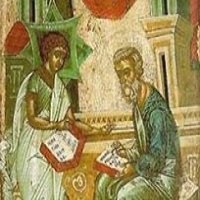
Matthew’s Gospel – Companion on the Journey
Matthew’s Gospel could be described as the “Gospel of the Messiah”. It begins with the Genealogy and the Annunciation to Joseph, followed by the five great discourses that mirror the five first books of the Hebrew Testament, the Torah. The discourses are the Sermon on the Mount (ch.5-7), the Commissioning the Twelve (ch.10), the Parables of the Kingdom (ch.13), The Church Life and Discipline (ch.18), and the Mount of Olives (ch.23-25).
Context
Each Gospel writer has a particular story to tell. They emphasise certain theological themes. The context of Matthew’s Gospel is the larger debate within Judaism concerning its future, the place of rabbinical teaching, and the meaning of messianic teaching. It is the most Jewish of the Gospels. It is closely linked to the Old Testament’s messianic prophecies. Matthew’s central theme is God’s promise to bring salvation to his people Israel, and to the whole world. Jesus is the fulfilment of this promise. Our response to this world-changing news is to return to the world as missionary disciples of Jesus (Matt 28:18-20).
The Genealogy
The Genealogy at the beginning of Matthew’s Gospel traces the history of promise and fulfilment. It gives Jesus legitimacy and places his ministry within the ancient promise: “This is the genealogy of Jesus the Messiah, the son of David, the son of Abraham”. Jesus is linked to Abraham, the one to whom God promised the covenant.
The Fulfilment
Matthew develops his theme that the promise is fulfilled by quoting the Old Testament prophecies. He uses the following formula: “This was to fulfil what the Lord had spoken through the prophet… .” The birth of Jesus to a virgin fulfils Isaiah’s prophecy (7:14), the escape to Egypt fulfils Hosea (11:1), and the Galilee ministry fulfils Isaiah (9:2).
Scripture
Matthew cites or alludes to scripture many times. In the scene between the Magi and Herod, Herod asks where the Messiah was to be born. The answer comes from the prophecy of Micah (5:2 & 5:4). Matthew takes the same approach with
John the Baptist is “the one about whom it is written” (Malachi 3:1).
Calling Jesus “out of Egypt” is a reference to the deliverance of Israel during the Exodus and a statement of the fulfilment of the promise.
Jesus As the New Israel
In Jesus, God’s promise is being fulfilled throughout human history, and history is heading toward its goal and culmination in Christ (Greek for Messiah). Matthew sees Jesus from this perspective, so the Jesus of Matthew’s Gospel is more than a wandering prophet or healer. Jesus is the completion of the Exodus experience: (1) comes out of Egypt; (2) tested for 40 days (40 years) in the wilderness; (3) intimately trusts God; (4) is the servant and aligned to the servant prophecy of Isaiah (chapters 40-42), (5) remains faithful to this calling. (6) continually turns outwards to the world (while Israel (us) turns inward to discuss phylacteries and the cushioning of the pews), (6) goes to the Cross.
The Servant Christ is the one in “whom nations will put their hope”; an eschatological (end-times) hope that gives human existence its ultimate meaning.
Matthew’s Identity, Audience, and Purpose
Traditionally, Matthew was a tax collector Jesus called to be his disciple.
Mark and Luke call him Levi. Matthew often presents Jewish social/religious constructs (ceremonial washings, temple tax, phylacteries and tassels, whitewashed tombs) without explanation, suggesting he wrote for a predominantly Jewish audience. Matthew commonly uses the description “kingdom of heaven” rather than “kingdom of God” because heaven is a common Jewish circumlocution for God.
Matthew’s strong polemic against the Jewish religious leaders suggests a Jewish-Christian community in conflict with the larger, orthodox Jewish community. The church represents the true people of God, made up of Jews and Gentiles, who have embraced Jesus as the Messiah and accepted his message of the kingdom of God.

